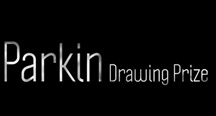2014 Judge's Report
A drawing can be many things - and the Parkin Drawing Prize 2014 goes a long way in a great many directions to prove that. When I embarked on the invigorating task of judging the award, I was looking for works in which I sensed the artist had been engulfed by the physical and mental act of creation. I had my own ideas of what a great drawing was. And I always keep in mind Paul Klee’s definition of drawing as an act of discovery, of knowing the unknown. As the Swiss-German artist wrote: ‘A line is a dot that went for a walk. A drawing is simply a line going for a walk.’ Beyond that, however, I found that the 80 selected artists forced me to invent new definitions of drawing. I’ll mention of few of these definitions, with a few relevant artists from the exhibition listed alongside:
A drawing is the place where the mind’s machinery meets the machinery of the world outside. (Douglas Stichbury)
A drawing is a set of instructions for looking at itself (David Brown)
A drawing is driving a vehicle along the border of an unknown country (Philip Madill)
A drawing is walking along the border of a known country (Denise Durkin)
A drawing is a great flowering of a great many things that are not flowers (Hannah Beehre)
A drawing is a tremor 3 surface of all that matters (Maria O’Toole)
A drawing is an accident waiting to not happen (Glen Hutchins)
A drawing is finding a way through (John Ward Knox)
The pencil says to the line: do you follow me? (Justine Walker)
Next, I found myself looking a little more closely at the word drawing—a noun if you think of it as a finished work of art, usually on paper, and traditionally rendered in pencil or pen and ink. However, if you think about drawing as a verb - an action or process - then you have to consider the bringing into being of the work as much as an end result.
And it was in this regard that the first of the highly commended works struck me. Taylor Wagstaff’s Meditation comprises a video on a three minute loop - but I have no hesitation considering it a drawing. In the work, we look down on a frying pan in a sink; a hand is wielding a scrubbing brush much the way an artist uses a pencil or crayon. To underline this connection, the soundtrack is cleverly evocative of the sound of pencil on paper. This kinetic film-work has the sumptuous charcoal tones and the hand/eye co-ordination of a great act of drawing, even if it is not a drawing in the usual sense.
The second highly commended artist is Dominic McElwee, for his panoramic Last Supper. This thirteen part series depicts a band of photo-realistic disciples under a Birth of the Cosmos disco strobe-light. I wish there had been more works in the exhibition that were as risky and out on a limb as this one. Why not take on Leonardo de Vinci? McElwee draws as though his life depends upon it; his drawing gets the badge for Urgency and Intensity.
The other three highly commended artists are unable to be with us tonight. First among them is Ruth Cleland for her Parking Building Detail with Grid, an almost sculptural wall - work which reiterates, with forensic precision, textures from the everyday world and places them alongside a geometrical grid. I’d love to see here working through this territory on a larger scale, salvaging heavenly symmetries from the ground-level detritus of the city. Also highly commended is Nicola Donna, whose work reminded me of the great domestic drawings and watercolours of the late Joanna Margaret Paul. Donna’s Ampa, Used Fireworks and Other Objects is youthful and frisky but also graceful - great qualities to find in a drawing, as in any work of art. And finally, among the highly commended works, John Ward Knox’s minute meditation on time and space, The Poems of James K. Baxter Typed On A Single Point…. Knox reminds us that drawing can be a form of conceptual art, and here the finished work remains nestled very close to its originating idea. He has used the moving arm of a typewriter stuck on a single space-setting to wear an aperture or window right through a sheet of paper. It is as if the poems of Baxter, which the artist was typing, have bashed their way through. The drawing is, at once, a full-stop and a void. A memorable gesture. End of story.
The winner of the Parkin Drawing Prize 2014 is a great drawing on paper, and also a great act of drawing. It is Douglas Stichbury’s large charcoal work, Observer. The drawing is clearly articulated, finely rendered using orchestral layerings of grey and black. At the same time it retains a sense of mystery and enigma - what story is this scene a part of, past, present or future. The title, Observer, alerts us to the figure in the image - an ambiguous, uniformed man sitting beneath a telescope or film projector (or might it be a piece of artillery?). I like to think the ‘observer' here is also a kind of self-portrait of the artist. That’s Douglas Stichbury deep inside the fabric of this drawing, looking upwards and outwards from there, making adjustments and taking aim... And, of course, we - the audience - are also 'observers', an essential part of this equation, lucky to be here to contemplate a drawing which is so fundamentally and eloquently all about the business of observing, looking and seeing.
